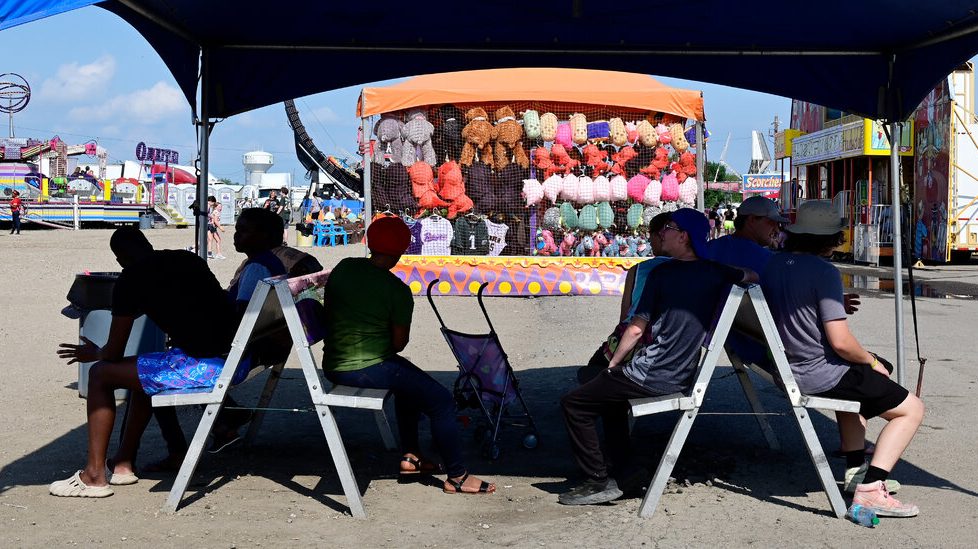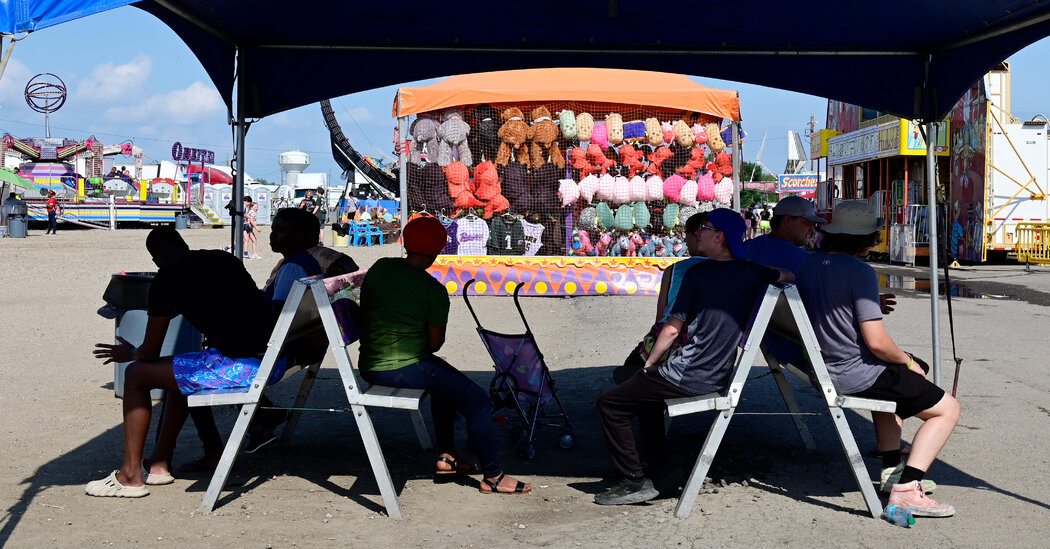Sizzling Day in North Dakota? Lately, It’s No Surprise.


After a morning filled with food and rides at a North Dakota county fair on Saturday, Bridget Bohn and her daughter, Clodagh, needed a break from the heat. They slumped on the ground in an air-conditioned building with water bottles by their sides, their cheeks flushed matching shades of red.
“We’re just trying to stay cool and healthy,” Mrs. Bohn, 36, said.
Clodagh, 5, chimed in from the floor, where she was lying on her back on the chilled concrete with a bag of cotton candy: “And not melt,” she said.
North Dakota is not known for scorching temperatures — the average high temperature in Fargo for July is in the low 80s. But on Saturday, Fargo and the areas surrounding the city were swept up in the same heat wave that gripped the West before shifting toward the Midwest and Northeast.
At the Red River Valley Fair, the heat index — a measure of how the weather feels when factoring in humidity — soared to 98, prompting the National Weather Service to issue a heat advisory for the afternoon. Forecasters warned that there was a major risk for heat-related illnesses because of the duration of the heat and how unusual it was for this time of year.
But at least on this day, and at this event, many North Dakotans shrugged off the high temperatures (flushed cheeks aside). The heat was something to take into account, perhaps by drinking water or taking breaks in the shade, but not cause for major concern.
“This is partly why we live in North Dakota,” said Louise Tegtmeier, 62. “Not too many 90-degree days.”
That may be shifting. Climate change is expected to increase the frequency, duration and intensity of heat waves. And over the last century, North Dakota has experienced more warming than most of the other states. Researchers estimate that the state has warmed by more than 2.5 degrees since the start of the 20th century.
At the fair, Ms. Tegtmeier was responsible for keeping small animals that were being exhibited cool. Around her, rabbits were splayed out in their enclosures, chickens of all sizes and colors panted, and turkeys stood with their wings held away from their body. A sheep, identified by a banner as the “Cass County Grand Champion,” rested against two portable fans.
If the animals were on a farm, Ms. Tegtmeier said, they would not be confined to small cages and could seek out their own sources of water and shade.
Harvey Morken, 70, who was sitting in an air-conditioned building filled with young livestock and educational displays, said the higher temperatures could help his crops. Pulling out an app on his phone that he uses to track his fields, he pointed to a measure of how much heat his corn and soybean fields had gotten this year. “Too low,” he said. “The heat is welcome.”
Like other fairs across the country, the Red River Valley Fair — which bills itself as “the best days of summer” — offers more than just entertainment. Held annually near Fargo, the largest city in the state, it provides local farmers an opportunity to showcase their livestock and crops. Young people participating in organizations such as 4-H and FFA are recognized for their skills in crafts and animal husbandry. The fair also brings together the local community, and attending is a tradition for some families.
As temperatures climbed Saturday afternoon, attendees found ways to stay cool where they could.
Trel Redhorn, 19, bought a large jug of lemonade from a vendor. “It was maybe $15 or $20,” he estimated. “Too much.” Then he refilled it with water. Natalie Schroeder’s two daughters, Clara, 7, and Addison, 4, wedged themselves inside refrigerator doors while the family sold soft drinks and water to raise money for 4-H.
For some, the heat was unavoidable. Ryan Gothrup, 47, a glassblower, spun out miniature pumpkins and flowers for sale in front of a furnace that he said could reach 2,100 degrees. The heat could be felt from the stands in front of his stall, where families gathered to watch.
“You get used to it, or else it would drive you crazy,” he said. His shirt was soaked through with sweat.
Fargo will cool down this week, with temperatures forecast in the high 70s and low 80s. But the heat wave stretching from the Great Plains to the East Coast is expected to persist for the next couple of days. Other Midwestern cities are still facing scorching temperatures; Lincoln, Neb., for example, is expected to reach a heat index of 110 on Monday. In Milwaukee, where the Republican National Convention is scheduled to begin Monday, the heat index is forecast to climb to 95.
At the fair Saturday, at least one group seemingly couldn’t get enough of the heat.
Five camels — Addie, Rami, Royce, Zibbi and Zaya — eschewed standing in a shaded area under a tent in favor of soaking up the sun. Colleen Pages, who travels with the camels, her husband, Hans Klose, and their other animals to fairs across the country from Sarasota, Fla., said the camels were used to hot and humid conditions.
“They love it,” she said.
The post Sizzling Day in North Dakota? Lately, It’s No Surprise. appeared first on New York Times.
